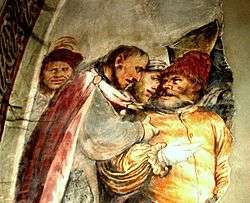Breno, Lombardy
Breno [ˈbreːno] (Camunian: Bré; obsolete German: Brenn) is an Italian comune of 4,986 inhabitants[2] in Val Camonica, province of Brescia, in Lombardy.
Breno Bré | |
|---|---|
| Comune di Breno | |
.jpg) | |
.jpg) | |
Location of Breno 
| |
 Breno Location of Breno in Italy  Breno Breno (Lombardy) | |
| Coordinates: 45°57′31″N 10°18′20″E | |
| Country | Italy |
| Region | Lombardy |
| Province | Brescia (BS) |
| Frazioni | Astrio, Campogrande, Degna, Gaver, Mezzarro, Montepiano, Pescarzo, Ponte della Madonna |
| Government | |
| • Mayor | Sandro Farisoglio (center-left) |
| Area | |
| • Total | 58 km2 (22 sq mi) |
| Elevation | 343 m (1,125 ft) |
| Population (2011)[2] | |
| • Total | 4,986 |
| • Density | 86/km2 (220/sq mi) |
| Demonym(s) | Brenesi |
| Time zone | UTC+1 (CET) |
| • Summer (DST) | UTC+2 (CEST) |
| Postal code | 25043 |
| Dialing code | 0364 |
| Patron saint | Saint Valentine |
| Saint day | February the 14th |
| Website | Official website, Official website |
Geography
It is bounded by other communes of Niardo, Bagolino, Bienno, Braone, Ceto, Cividate Camuno, Condino (TN), Daone (TN), Losine, Malegno, Niardo, Prestine.
The town of Breno stands in a north-south gorge, between the castle hill and the Corno Cerreto, on the left bank of the river Oglio. According to professor Fedele the gorge was once the bed of the Oglio.
History
On top of the castle hill a house dating back to the Neolithic was discovered. In the locality Spinera, at the river Oglio, there is the Sanctuary of Minerva of the first century CE, which was ruined in the fifth century.
In the Middle Ages the Castle of Breno had two towers, one belonging to the Guelph family Ronchi, the other to the Ghibelline family Alberzoni. In the 1397 peace of Breno between Guelphs and Ghibellines, the representatives of the community of Breno sided both with the Ghibellines and the Guelphs.
During the Republic of Venice rule Breno was the seat of the Community of Val Camonica. Breno today is the seat of the Comunità montana di Valle Camonica.
The emblem of the province of Brescia is the group of five blazons: that of Brescia in the center, the town of Chiari, Breno, Verolanuova and Salò.
Monuments and places of interest
.jpg)
.jpg)
.jpg)
.jpg)

Religious architecture
- Parish Church of San Salvatore (Duomo), the seventeenth-century structure located in the center of the country, with frescoes by Antonio Guadagnini. The altars are in marble of Ono San Pietro.
- Church of Sant'Antonio Abate, preserves notable works of art: between them should be mentioned first of all the important cycle of frescoes realized by Romanino.
- Church of St Maria at the Bridge (or Minerva), the'500, onto the structure is the temple of Minerva.
- Church of San Carlo, the seventeenth century, with significant number of ex-voto.
- Church of San Maurizio, an ancient parish.
- Chapel of St. Apollonia, the road leading to St. Valentine.
- Church of San Valentino, fifteenth construction, interior perhaps Giovanni Pietro da Cemmo.
Military architectures
The Castle of Breno rises over a hill inhabited already in prehistoric times. It was the main bastion for the control of Valle Camonica until the seventeenth century.
Demographics
Demographic trends

Culture
Traditions and folklore
The scütüm are in camunian dialect nicknames, sometimes personal, elsewhere showing the characteristic features of a community. The one which characterize the people of Breno is Maia càrte or Pèla pàsser
Museums
CaMus
The Museo Archeologico della Valle Camonica is located in Breno, also known as the Museo Camuna, and contains artifacts and artworks documenting the history of the region. Among the painting collection, are works by:
- Emilian 14th century master - I sette dormienti nella spelonca
- Venetian 16th century - Madonna with Bambino, Sts. Sebastian & Rocco
- Callisto Piazza da Lodi - Deposition
- Girolamo Romani detto Il Romanino - Crucifixion
- Anonymous 16/17th century - Triumph of death
- School of Bellini - Holy family & St. John
- Northern master - Capture of Christ
- Camillo Procaccini attributed (Bologna 1551-Milan 1629) - Martyrdom of St. Bartholemew
- School of Procaccini - Allegory of Flora crowned by genius
- Venetian 17th century - Adoration by Magi
- School of Ribera - St. Bartholomew
- School of Caravaggio - Incredulity of Thomas
- Giacomo Ceruti (Milan 1698-1767) - portrait of Cattaneo family member
- Felice Riccio detto Il Brusasorci (Verona 1540-1605)
- Francesco Giugno
- Francesco Monti (il Brescianino)
- Giulio Carponi
- Gaspare e Antonio Diziani
- Bice Del Balzo nel castello di Rosate
- Francesco Hayez
- Faustino Bocchi (Brescia 1659-1741) - Bambocciata
- Enrico Albricci (Vilminore di Scalve, BG 1714-Bergamo 1775) - Serenade by Bambocci
- Ponziano Loverini (Gandino, BG 1845-1929)
- Antonio Guadagnini (Esine, BS 1817-Arzago d'Adda, BG 1900)
References
- "Superficie di Comuni Province e Regioni italiane al 9 ottobre 2011". Istat. Retrieved 16 March 2019.
- ISTAT Archived March 3, 2016, at the Wayback Machine
Bibliography
- Panazza, Gaetano; Araldo Bertolini (2004). Arte in Val Camonica - vol 5 (in Italian). Brescia: Industrie grafiche bresciane.
External links
| Wikimedia Commons has media related to Breno. |
- (in Italian) Historical photos - Intercam
- (in Italian) Historical photos - Lombardia Beni Culturali
.jpg)
.jpg)